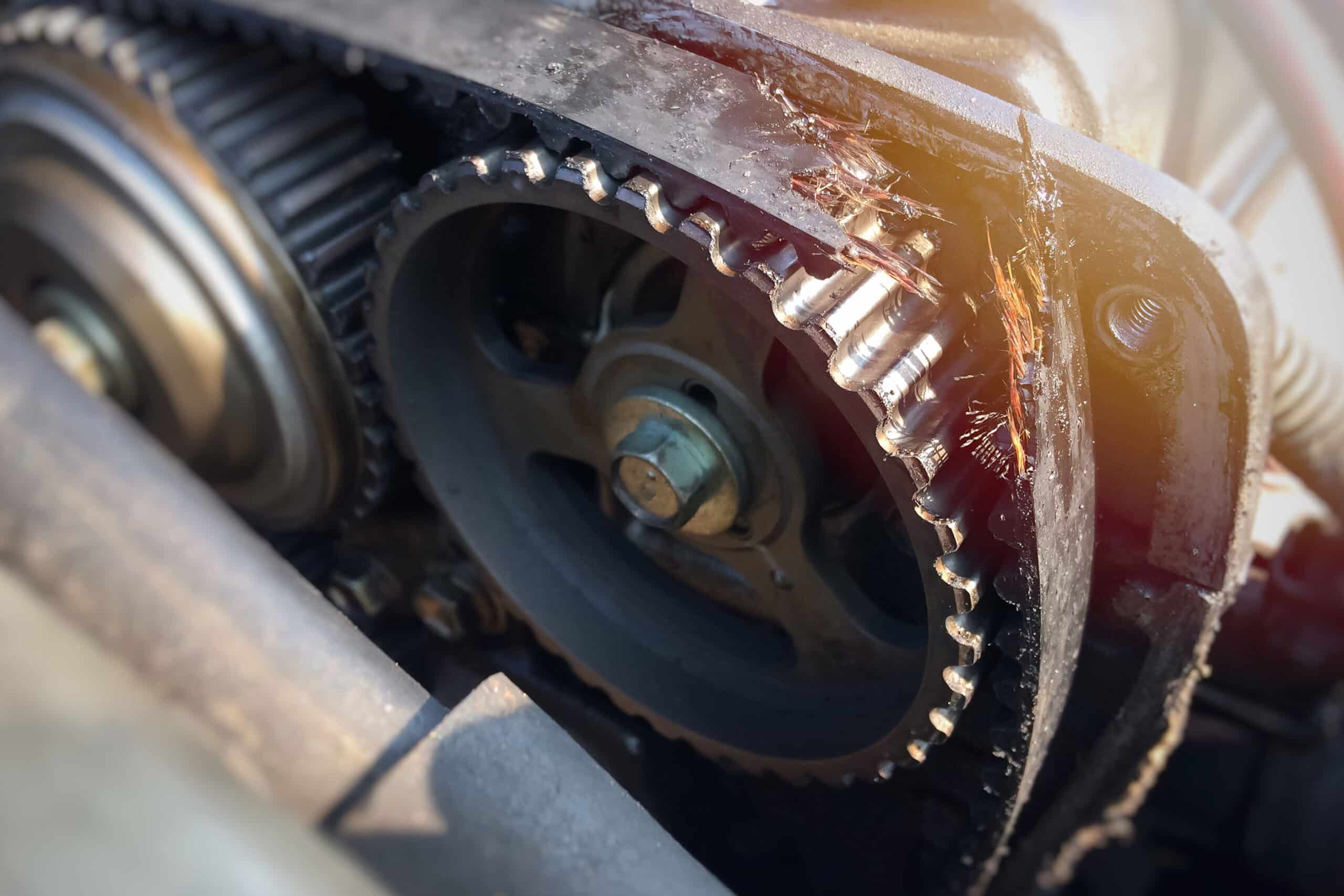
Worn Timing Belt Signs: Recognise The Red Flags
The timing belt, often overlooked, is the unsung hero at the core of your automobile’s engine. Its purpose is as critical as it is unassuming: orchestrating the vital harmony between pistons and valves. It synchronises the rotation of the crankshaft and camshaft, ensuring that valves open and close at the right time. It plays a very critical role in the proper functioning of the engine. When this crucial component begins to show signs of wear, it’s important to recognise them, for a worn timing belt can bring your vehicle to an unexpected, grinding halt.
Imagine your engine as a finely-tuned ensemble, with each piston and valve playing its part. The timing belt is the conductor, subtly ensuring each component hits its mark at the exact right time. However, even the most robust conductors can falter. Understanding this, we equip ourselves with the knowledge to prevent minor issues from spiralling into major setbacks.
It’s important to understand the red flags of a worn timing belt, unmasking the subtle signs that could spell the difference between a simple trip to the mechanic and a full-blown roadside emergency. By learning more about the significance of your timing belt, you’ll be armed with a clear understanding of your vehicle’s health, turning every drive into a confident journey and empowering you to take charge of your car’s performance.
Understanding the Timing Belt
The timing belt, elegantly tucked away under the hood, may not be the star of the show, but it’s the backstage hand that ensures your vehicle’s performance never misses a beat.
In essence, the timing belt is your engine’s metronome. It governs the harmonious dance between the crankshaft and camshaft, ensuring that the engine’s valves open and close at just the right moments during each cylinder’s intake and exhaust strokes. This precise coordination is fundamental to your engine’s ability to run smoothly and efficiently.
Why does this matter? A perfectly tuned timing belt translates into an engine that runs with seamless rhythm, delivering optimal power and fuel efficiency. On the flip side, a worn or faulty timing belt can disrupt this harmony, leading to a host of engine problems, reduced performance and in the worst-case scenario, a total engine failure.
Now, imagine the timing belt system as a beautifully choreographed ballet, with every component playing a critical role. At the heart of this performance is the timing belt itself, a toothed belt that rotates the engine’s camshaft in sync with the crankshaft. The tensioner and idler pulleys ensure the belt maintains the right amount of tension and alignment. Lastly, the timing belt cover protects these components from dirt, debris and any potential foreign objects that could disrupt the system.
Each part of the timing belt system works in unison, maintaining the delicate balance required for your engine to perform at its best. By understanding the significance of this mechanism, we become more aware of our vehicle’s health, ready to catch any early signs of a worn timing belt.
Lifespan & Replacement Guidelines
A critical part of maintaining your vehicle’s performance lies in understanding the lifespan of the timing belt. Just like how every car has its own distinct personality, every timing belt has its unique lifespan. Depending on the make, model, and engine type of your vehicle, this lifespan can vary considerably.
Typically, in Australia, a timing belt is designed to last anywhere between 100,000 to 150,000 kms. But remember, this range is not a hard and fast rule. It’s rather a guiding star, a reference point from which individual circumstances can cause deviation. Therefore, always consider the manufacturer’s recommended replacement intervals, as these take into account the specific design and requirements of your vehicle.
These replacement intervals aren’t mere suggestions, they’re essential milestones on your vehicle’s journey. Adhering to them is like performing a well-timed pit stop in a race, keeping your car in prime condition for the road ahead. Neglecting these intervals can lead to a worn belt overstaying its welcome and that’s a risk that could result in costly repairs.
Just as important to consider are factors such as mileage, age and driving conditions, all of which can greatly impact the timing belt’s lifespan. High kms, older vehicles may require more frequent belt replacements. Similarly, harsh driving conditions—think stop-and-go traffic or frequent short trips—can accelerate wear and tear.
In essence, the lifespan of your timing belt is a balancing act, one that weighs the manufacturer’s recommendations against the realities of usage and conditions. Understanding this balance is key to ensuring the health and longevity of your vehicle’s engine. It empowers you to stay one step ahead, timing your vehicle’s maintenance to the rhythm of the road.

Picture of a severely damaged timing belt in need of immediate replacement
Signs Of A Worn Timing Belt
The realm of a worn timing belt can bring about noticeable changes in your vehicle’s engine performance. Subtle shifts might start to occur, often indicating that your timing belt is on the cusp of retirement.
Here are 7 signs that your timing belt may be wearing out and in need of replacement.
- Decreased Engine Power: If your vehicle seems less responsive or struggles to accelerate as it normally would, this could be a sign of a worn timing belt.
- Rough Idling: When the car is at a standstill but the engine is running, you might notice the car vibrating or shaking more than usual. This is often due to timing issues caused by a worn belt.
- Engine Misfire: A worn timing belt can cause one of the cylinders to open or close too early or too late, leading to an engine misfire.
- Unusual Noises: Ticking or rattling sounds coming from the engine could be a sign that the timing belt is wearing out.
- Difficulty Starting the Engine: If the car has trouble starting or won’t start at all, the timing belt could be the culprit.
- Engine Stalling: A worn or broken timing belt can cause the engine to stall, as the timing between the valves and pistons is disrupted.
- Visible Wear on the Belt: On visual inspection, if the belt appears glazed or frayed, or you can see visible cracks, it’s likely the belt needs replacing.
Remember, these signs aren’t definitive proof of a worn timing belt, but they are strong indicators. Interpreting these changes in engine performance as early warning signs gives you a valuable heads-up. It’s your vehicle’s way of telling you that it might be time to inspect and possibly replace the timing belt and a key step in proactively maintaining your vehicle’s health.
By recognising these signs, you’ll be able to act before a worn timing belt has the chance to bring your journey to an abrupt stop.
Preventive Maintenance and Replacement
In the dynamic world of timing belt maintenance, prevention often proves to be the most effective strategy. When it comes to your timing belt, proactive measures can not only extend its lifespan but also safeguard your vehicle against unexpected performance issues and costly repairs.
There are 3 core ways to prevent timing belt damage. These include:
- Regular Inspections: Have your timing belt periodically inspected by a professional mechanic to catch early signs of wear and tear.
- Follow Manufacturer Recommendations: Your owner’s manual is a treasure trove of information, providing guidance on maintenance intervals that are tailored specifically to your vehicle model. Whether it suggests timing belt inspections every 100,000 kms or replacements every 150,000 kms, these recommendations are designed to keep your vehicle in prime condition.
- Promptly Address Issues: If any problems are detected during an inspection, promptly arrange for necessary repairs or replacement. Don’t procrastinate on the necessary repairs or replacement. It might seem inconvenient at the moment, but quick action can save you from future headaches and hefty repair bills.
What To Do If You Suspect a Worn Timing Belt
When it comes to a worn timing belt, time is of the essence. Recognising the signs is only the first half of the equation. The immediate action that follows is equally crucial.
If you observe any of the aforementioned symptoms in your vehicle, don’t turn a blind eye. Remember, the timing belt is integral to your engine’s harmony and a worn belt threatens to disrupt this balance. Act swiftly—treat these signs as a call to consult with a professional mechanic who deals specifically with timing belt replacement.
A timing belt replacement expert can inspect the belt, confirm your suspicions and provide an accurate diagnosis. They’ll look for tell-tale signs of wear, checking for cracks, fraying or other forms of visible damage. If the timing belt is indeed worn, they’ll advise you on the best course of action, which typically involves a prompt replacement.
Neglecting or delaying a timing belt replacement is a gamble that could have costly repercussions. The worst-case scenario is a timing belt failure, where the belt snaps, causing the engine to lose its timing. When this happens, the pistons can collide with the valves, leading to extensive engine damage that could cost thousands of dollars to repair.
Your vigilance and timely action are paramount in maintaining your vehicle’s health. If you suspect a worn timing belt, reach out to a professional for a thorough inspection. It’s far better to shoulder the cost of a replacement than to risk the potential fallout of a complete timing belt failure. Stay informed, stay observant and ensure your vehicle remains the reliable companion it was designed to be.
Repair, Replace, Maintain. What Are The Next Steps?
When it comes to replacing the timing belt, it’s vital to employ high-quality components and seek professional expertise. Your timing belt plays a critical role in your engine’s operation, so this is not the time to compromise on quality. Additionally, the replacement process requires precise technical skills to ensure correct installation and tension, making it a task best left to professional mechanics.
Embracing proactive timing belt replacement as part of your regular vehicle maintenance has clear benefits. It keeps your engine running smoothly, maximizes fuel efficiency and prolongs the life of your vehicle. Plus, knowing that your timing belt is in good condition gives you peace of mind each time you hit the road.
Preventive maintenance is a small investment that can yield significant returns. Regular inspections, adherence to manufacturer recommendations, prompt attention to issues and timely replacements with high-quality parts are your best defence against a worn timing belt. Stay ahead of potential issues and keep your vehicle humming to the beat of optimal performance!
Auto Stop are professionals in timing belt replacement and we have a comprehensive service for timing belt replacement in both Brisbane and Gold Coast. Contact us for any timing belt issues you may have, we’re here to help.


